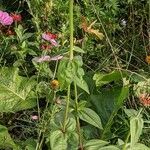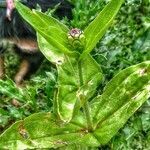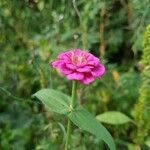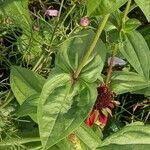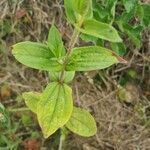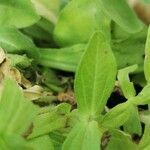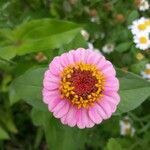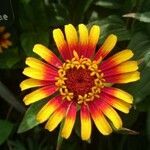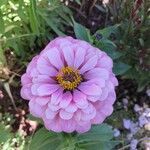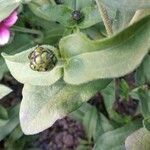Erect annual (20–) 30–60 (–120) cm high; stems striate, hairy. Leaves sessile, lanceolate, ovate or oblong, 25–135 mm long, 10–40 mm wide, scabrous; bases truncate, obtuse or subcordate. Capitula hemispherical, to 2.2 cm diam. (excluding rays); involucral bracts obovate to broadly obovate, rounded and erose apically, glabrous, not or hardly banded at apex; Paleae acute or acuminate, deeply fimbriate apically. Ray florets c. 8–20; ligules broadly oblanceolate, 1–2 (–3) cm long, basally hairy abaxially especially on veins, usually pink to purple, rarely white, yellow or red-orange. Disc florets numerous; corolla dilated at base, with tube yellow or orange; lobes velutinous, black extrorsely. Ray achenes oblanceolate to cuneate, 3-angled, 6–8 (–9) mm long, pilose, unawned. Disc achenes broadly oblanceolate to cuneate, 2-angled, 5–6 (–9) mm long, ciliolate or glabrous, emarginate; awns absent or 1, very short.
Heads radiate, the rays yellow, pistillate and fertile; invol bracts in 2 or 3 slightly unequal series, the outer subherbaceous, the inner more chartaceous and sometimes transitional to those of the receptacle; receptacle slightly convex, its bracts rigid, clasping the achenes; disk-fls perfect and fertile; style-branches flattened, with elongate, hairy appendage; achenes glabrous, quadrangular, or those of the rays triquetrous; pappus a short dentate crown; ± fleshy seacoast shrubs with opposite, usually canescent lvs. 7, warm Amer.
An annual plant. It grows to 1 m high and spreads to 1 m wide. The stem is erect, branching and brittle. The leaves occur opposite one another and can be oval or long. They are deep green and clasp the stem. The flowers can be of various colours such as white, yellow, red, or orange. They occur singly and are at the end of branches or in the axils of leaves. Flowers can be 12.5 cm across.
